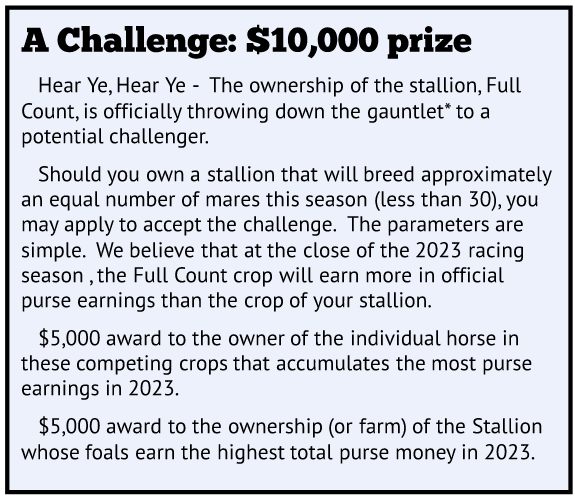

Death by a Salesman (Part 3)
by Trey Nosrac
Thursday night, at the Smoke and Beerors Tavern, I continued to revolutionize the stallion business. Rhetorically, I asked my wealthy patron a difficult question.
“What does one do with a stallion that gets fewer than 25 mares in a season?A stallion that may be old, questionable, falling out of favor, or has never been in favor?”
He gazed at his glass of Coor’s Lite, “My answer would be: get another stallion.”
“Suppose you have affection for this old stallion, he may be more of a pet than a financial investment?”
He shrugged, “Then, I have no idea.”
“I do.”
“Of course you do.”
“My suggestion for a struggling stallion in this situation is something I just invented called the Stallion Challenge. My plan is more whimsical than a fiscal windfall, a brilliant marketing tool that might stir up a few more bookings. Most of all, it could be fun.”
“For who?”
“The breeding farm, the owner, and the buyer.”
“Clarify and continue your insanity.”
“Imagine you own a stallion that will get fewer than 30 breedings. Let’s say that you own Full Count, an aging, underrated, Ohio stallion. The ownership of Full Count has confidence and decides to issue a challenge to other trotters in the same boat. The challenge begins with posting this notice.
“Is this real?”
“No, at this point, the challenge is hypothetical. But what would life be without hypothetical questions?”
“Where would the prize money come from?” he asked.
“Each stallion owner would put up $5,000. But remember, one of the two will get their money back. My thinking is that if this quirky challenge spurs one or two additional breedings, it will create a positive cash flow for the sponsoring competitors.”
“You’re suggesting a small incentive to possibly push buyers to do some business with a not-so-hot prospect?” he asked.
“Sure. As a buyer, I’m looking at one of those sub crops of maybe 60 horses from these two stallions. I know that not all the mares will carry to term, not all the foals will race, and the stallions will probably not get top-tier mares. To the minds of overoptimistic broodmare owners like me, this is equine cocaine. We know OUR foal will race. We know that OUR mare will be the best of this lot. Suddenly, to our delusional minds, this $5,000 carrot feels like free money.”
“Do you think it would make a difference? Do you think this little perk would push a few owners to breed to a stallion in this category?”
“I’m not sure.”
“Wow, humility, from Trey.”
“Yeah, the world needs another genius like me with humility; there are so few of us left. What’s the downside? The quirky little side game couldn’t hurt. I mean, buyers are fickle. Weird things can be tipping points. For someone like me, granted not a normal person, this extra perk could be a factor. Following the competitors in the challenge and a potential $5,000 bonus gets my attention.”
He summed up, “So… at best you get a few mares going to a couple of aging stallions, who will be very aging stallions by the end of the contest. This scheme doesn’t feel like a tidal wave to perk up the stallion business and recruit new owners.”
“Baby steps,” I said. “I used two elderly stallions in my model. Similar models could be used by other stallions who face a bleak future, stallions with flaws in the eyes of the marketplace.”
“Flaws?”
“Yeah, maybe the stallion is an unraced brother of a great champion, or your stallion was a fast horse with a marginal family, or a foreign horse, or a well-bred horse that was a dud on the racetrack.There will be a long list of stallions that, for one reason or another, will not get much business.
“You think these ‘small crop challenges’ could work?”
“Who knows? All it requires is that a few stallion owners have enough audacity to set up these little side pools, advertise, throw down the gauntlet, and accept the challenge. The pools could be fun for farms, fun for owners, and fun for the customers.Winners could get trophies, and there could be good-natured trash talk. Operators could be innovative. Foolishness is nothing to fear.”
















